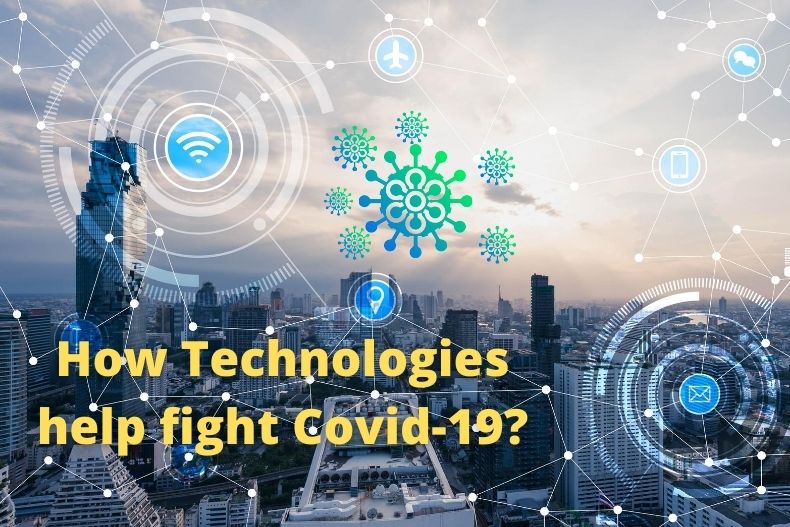The use of technology has proven effective in helping people overcome the adverse effects of the COVID-19 pandemic. From providing the necessary tools to make work-from-home possible, to converting brick-and-mortar stores into ecommerce, to shifting to alternative learning methods like online and distance learning, technology has become an essential investment for both businesses and consumers.
While it’s true that the COVID-19 pandemic has affected many lives and livelihoods, we cannot deny the fact that we are more equipped than any era in history to respond to a pandemic because of the availability of various technological advancements.
The following technologies are essential in helping the government and the people fight the COVID-19 pandemic:

Satellites
Satellite technology is capable of geographical monitoring, data analytics, and processing. China used satellite technologies to help them in non-stop monitoring of makeshift hospital constructions. Also, the data processing capability of satellite technology, combined with geocoding, helped create a health visualization of COVID-19. This allows people to see the geographical reach of the virus and could find out the distance between them and active infection.
Satellites can see important proxy indicators that are helpful in modeling, monitoring, responding to, and recovering from infectious disease outbreaks. Because most outbreaks tend to be place-based — which means they develop in certain places and are transmitted along certain pathways — geospatial data is becoming an essential tool for infectious disease modeling.
Once the dynamics of a disease are modeled and understood using high-quality geospatial data, satellite imagery can be used to monitor places where it is more likely to emerge or to look for the prevalence of certain risk factors. Further, by tracking the movements of goods in ports and elsewhere, satellite imagery can also be used to measure the economic impacts of an outbreak and its pace of eventual recovery.
Health sensors and app-based contract tracing
Health sensors and apps can help track millions of people each day, which is an essential tool used by China to monitor those who have symptoms of the disease, those who should stay quarantined, and those who can be allowed to go out.
The contact tracing apps are also helpful when it comes to finding and alerting the contacts of people infected with the coronavirus. The purpose of this digital contact tracing is to identify people potentially exposed to the coronavirus and advise them to self-isolate.
App-based contact tracing and health sensors can help mitigate the risk of spreading the virus especially because infected people can transmit the virus for days even before they develop symptoms. Also, it can take several more days for public health investigators to learn about a case and confirm it with testing.
These technologies, however, are only as strong as the health system’s ability to follow up with the users identified to be exposed to the virus, test them, and offer support during quarantine.
Robotics and artificial intelligence
The use of robots has been proven to be helpful and effective in preventing the spread of the virus. In fact, robots are positioned in the frontline these days as much as (or even more than) humans. Robots are exposed to a variety of tasks — such as preparing meals, serving as waiters, spraying disinfectants, dispensing hand sanitizers, and disinfecting the infected areas.
Some hospital facilities these days have become completely smart and digital. Most of the devices in the hospitals are enabled by the internet of things and their services are carried out by robots. For instance, the initial screening of the patients in some hospitals is done by 5G-enabled thermometers that send instant updates.
Some use rings and bracelets that are connected to an AI platform so that it can monitor all changes in the body. Others use robots to deliver food to COVID-19 patients, and those who are held under quarantine. This can greatly help decrease the spread of the virus by limiting human-to-human interactions, especially to those who are directly infected with the virus.
In the same way, the use of artificial intelligence helps medical professionals to understand more about a lot of diseases. There are tools that can effectively screen large populations and AI-powered infrared systems that have the ability to detect change in a person’s body temperature are also being used.
Other technologies used to combat the virus
Other technologies being used to help combat COVID-19 include cloud services, drones, and autonomous vehicles. The cloud services are essential because access to public information has helped in continuously monitoring the virus. Drones and autonomous vehicles are used for transporting both medical equipment, patient samples, and deliveries of essential goods. This helps save time and enhances the speed of deliveries, while preventing contamination of medical samples and decreasing human contacts.
Aside from technologies, there are essential services that remain active in the midst of the pandemic. These services are also necessary in helping the people overcome the effects of this crisis, including:
Mental health services
The COVID-19 pandemic has become stressful to a lot of people, especially to those who were directly affected by the crisis. Public health concerns, safety measures, and the closure of business have increased stress and anxiety in most people. To help the citizens cope with their mental health issues amidst the pandemic, many countries keep several mental health services open and accessible for all.
Other essential health services
Even with the pandemic, other diseases that need immediate attention still exist. However, getting yourself checked by a specialist can be quite risky. This is the reason why many medical professionals are now offering digital consulting services where patients can e-meet with their doctors for a consultation. With the help of technology, this has been made possible.
eCommerce
While most people are affected by stay-at-home orders, they still need access to essential goods and other necessities. Businesses have also been affected by the pandemic primarily because of quarantine orders and lockdowns. Fortunately, thanks to the availability of internet and modern technology, some businesses, especially retailers and even wholesalers, can still cater to people’s needs through converting their brick-and-mortar shops into ecommerce.
Nowadays, we can purchase most of our necessities online, making our basic needs easily available even during lockdowns. The emergence of eCommerce has become very useful and it has helped a lot of consumers, including the people in the frontline who do not have the time to go shopping for their needs.
eLearning
Many schools have chosen to close down while this health crisis is still ongoing, however, students’ learning should not be totally halted. Thankfully, students can now continue their schooling even at the comfort of their own home through the availability of online distance learning. Digital learning has become possible thanks to the power of video conferencing and elearning platforms where educators can connect with students.
Other necessary services
While most essentials are now available for purchase online, there are other services that remain open to serve consumers, such as banks, grocery stores, drugstores, and even restaurants and laundry shops. Some of these services utilize the help of robotics to help minimize the risk of getting their employees infected and spreading the virus.










